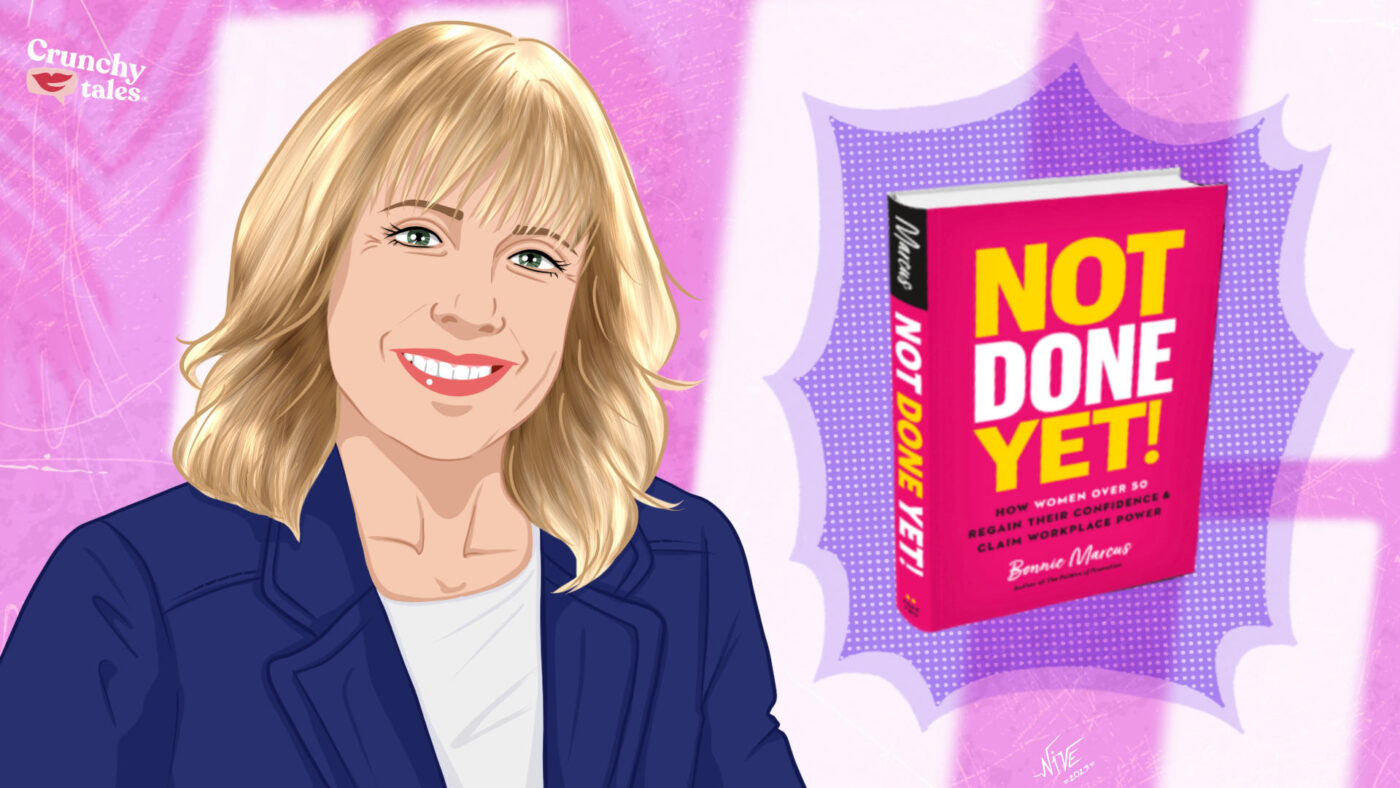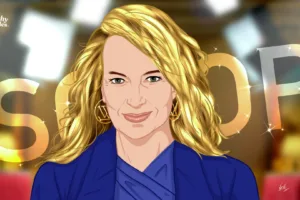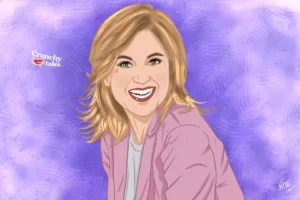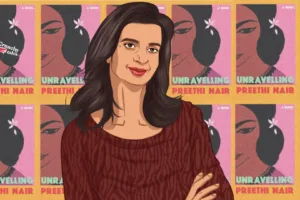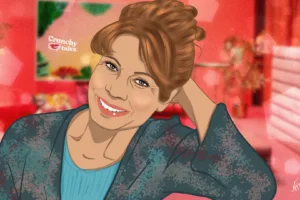Executive Coach Bonnie Marcus: “We’re Not Done Yet”
Award-winning entrepreneur, Forbes contributing writer, and executive coach, Bonnie Marcus, M.Ed., started her corporate career at an entry-level position and worked her way up to the top of a national company. Now, her passion is to help other women embrace their talent and ambition and step into their full potential, whatever their age.
Convinced that women over 50 are “Not Done, Yet!“, she has recently come up with her new book shining a light on gendered ageism in the workplace and gives women the tools and the voice to defy ageist assumptions to stay marketable and keep their jobs.
Crunchytales has met the fabulous podcaster and certified coach – who has been honoured by Global Gurus as one of the world’s top 30 leadership professionals in 2015-2021 – to find out why we can be “Badass Women at Any Age”.
Bonnie, would you give me three reasons why women over 50 are not done yet, whether in life or in the workplace?
Because women over 50 have the wisdom and experience to enrich and guide others. Because women over 50 offer a valuable unique perspective on life and work that their younger colleagues lack. Because women over 50 rock!
More and more midlife women decide to go back to work but they usually find several roadblocks. Many of them suspect they have often been dismissed as potential candidates because they are over 50. Is it real?
Yes, it’s real! According to research by Urban Institute, it takes women over 50 at least 2 years to get re-hired once they have either left the workforce or were prematurely dismissed. Women 50 to 61 are 18% less likely to find new work than at age 25 to 34. At 62+, they are 50 per cent less likely to be rehired. Women over 50 are unemployed longer. They often have to take a significant pay cut.
In a recent EEOC study, economists sent about 40,000 invented resumes to employers who’d advertised jobs, then analyzed which applicants got callbacks. The callback rate declined with age. But the age factor proved even stronger for women.
The increased utilization of artificial intelligence by companies for hiring and recruitment further complicates the issue as potential employees over a certain age often are excluded from the pool of qualified candidates. The lack of women involved in coding the algorithms as well as the reliance on historical data which is often more likely to be based on male employees, hurts women over 50, especially those who have a gap in employment due to caregiving responsibilities or forced early retirement. The algorithms don’t take into account the nuances of a woman’s career and aren’t likely to consider applicants over 50 unless the job description/qualifications specifically state so.
What women over 50 need to do to position themselves effectively is to understand the value they bring to an organization and articulate to a potential employer how they can help them reach their objectives. In other words, instead of emphasizing their long employment history, focus their communication on how they can help the company reach their goals, overcome their challenges and move forward, based on how they achieve positive results.
What should we do in order to challenge gender ageism?
Before the #MeToo movement, women who experienced sexual abuse or harassment remained silent due to shame and a feeling of helplessness. They didn’t feel they had a voice or platform from which to address the issue. #MeToo helped women find that voice and stand together to call out their unfair experiences and perhaps seek legal action.
In my opinion piece in The Chicago Tribune, I address the fact that women facing gendered ageism can also fall victim to the unfair (perhaps illegal) treatment. The tendency is to remain silent rather than bring attention to our age. When we feel shame about growing older, we can be easily victimized, marginalized, and/or pushed out for being irrelevant.
We need to understand our rights and call out gendered ageism when we witness it or experience it. Often expressing how certain behaviors or comments make us feel is a great way to start a dialogue and educate others about gendered ageism.
Certainly, discussing it with your HR representative or manager is also appropriate and serves to bring attention to how gendered ageism is affecting you in the workplace. Finding allies and champions in the workplace setting who can support you and your success is extremely helpful.
To reboot our life and career, you often talk about the importance of finding a sponsor. Where can we find him or her and how can we catch our potential sponsor’s attention?
A sponsor is someone, male or female, who holds a high-level position who can use their power and influence to help you reboot or advance your career, and someone who understands the value you bring to the organization.
The first step is to identify potential sponsors and build and nurture relationships with them over time. You will need to find a way to be visible and build credibility with them. For example, are there certain projects they are involved in that you can volunteer to work on? A sponsor needs to not only understand the value you bring to the work but also why sponsoring you makes sense for the company.
The important thing to note is that these relationships take time to nurture. The sponsor must trust that you are committed to the company and to delivering good quality work going forward.
Your tips might work very well in the US or the UK, countries where there are usually more opportunities and the go-getter attitude tends to work. But how can we shine in other environments where it tends to be more of a “who you know” rather than “what you know” case?
In my first book, The Politics of Promotion, I discuss how to create credibility and visibility for yourself and the importance of building a strategic network that supports your ambition.
Identify people in your organization who have power and influence over your career. Create a plan to intentionally build and nurture relationships with these people. It’s important that people at all levels of the organization know your value and can advocate for you when you are not in the room or are hesitant to advocate for yourself. Allies and champions as well as sponsors are extremely important to help position you as a valuable contributor. In other words, “who you know” helps get out the message of “what you know”.
Create a visibility plan for yourself. Where can you get more involved and visible to people with influence? Maybe it’s special projects, working with an executive sponsor within an ERG, or starting a lunch and learn program in your department. What works in your work environment? Make a strategic plan and commit to it.
Your latest book “Not Done Yet!” helps us unleash our inner badass. But, considering the current economy, what if there aren’t any seats available at the table?
As Shirley Chisholm famously said, “If they don’t give you a seat at the table, bring in a folding chair.” In other words, create your own opportunity.
I have a client now who has the ambition to be the CTO of her tech company. Currently, she is at the director level and there is no CTO position at her company so that gives us the opportunity to write a job description that showcases how she can help the organization move forward based on her value. We first worked on identifying her value proposition, or how her work leads to positive business outcomes. The next step is to identify what challenges and opportunities the organization presently has, and then connect the dots. In other words, she needs to communicate how she can help and why it’s in the company’s best interests to have her in the position.
The important message here is that once you understand your value, you can see opportunities for how you can help your organization reach its objectives based on how you successfully get results. Connecting the dots and then communicating what you bring to the table establishes you as a valuable contributor.
What have you learned about yourself from your journey so far?
I’ve learned how to use my wisdom and experience to empower other women to overcome their fears and limiting beliefs and reach their full badass potential. My own experiences, from starting at an entry level as a young single mom to CEO of a national company have taught me a lot about what it takes for women to be successful at any age.
I’ve learned that all my mishaps and disappointments have taught me valuable lessons about life and relationships, to prioritize what’s most important. I’m learning not to beat myself up for making mistakes but to see them as opportunities to expand my knowledge and wisdom.
I’ve learned that when faced with obstacles, I rise to the occasion and tackle them head-on. I’m challenged by these obstacles and my overall optimistic mindset helps me to find the determination to push through the barriers. I’ve learned that I’m a badass and I’m proud of it!
Last but not least, I know you’re a grandma and these days modern grannies are everything but women knitting in a rocking chair. Goldie Hawn and Jane Seymour are grandmas too, after all! What’s so exciting about this new phase of life?
I think one of the most exciting things is to witness my children as parents and the pride that I feel as I see them raising their kids in a challenging world.
But most of all, I love to play! And having grandchildren gives me the opportunity to let loose and be a kid again. Some of my most joyous moments at this stage of life are playing and connecting with my grandchildren on their level. I believe that experiencing this joy is fundamental to living a fulfilling life. It is this joy that fuels my ongoing optimism and positivity.
Like this post? Support Us or Sign up to our newsletter to get more articles like this delivered straight to your inbox!

